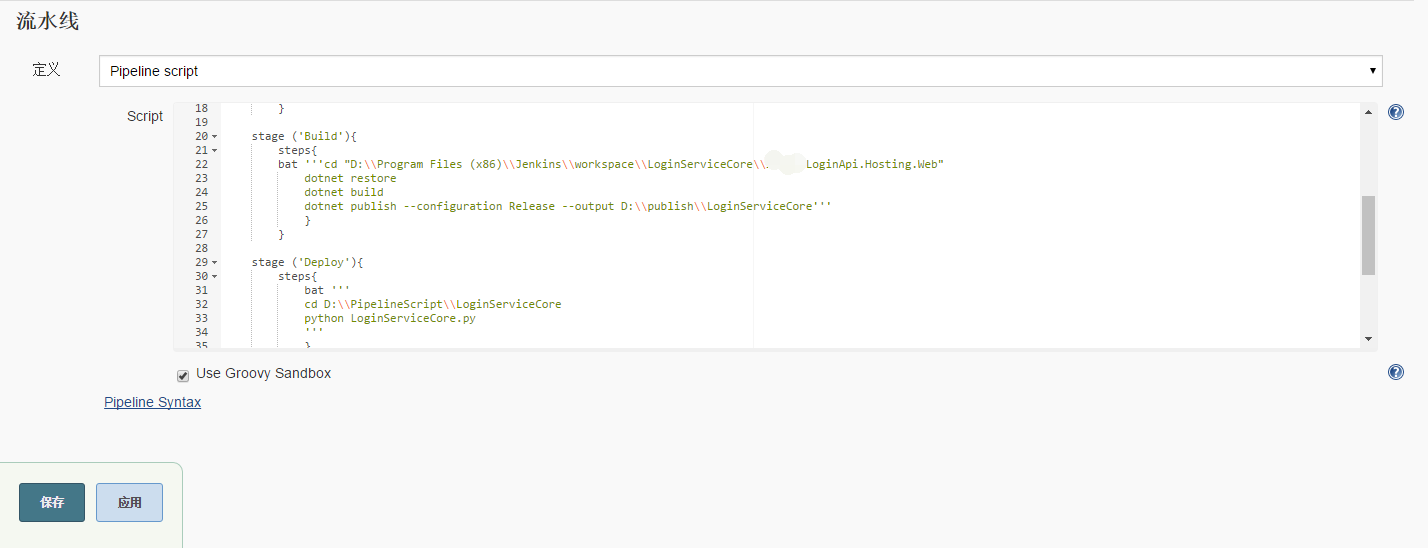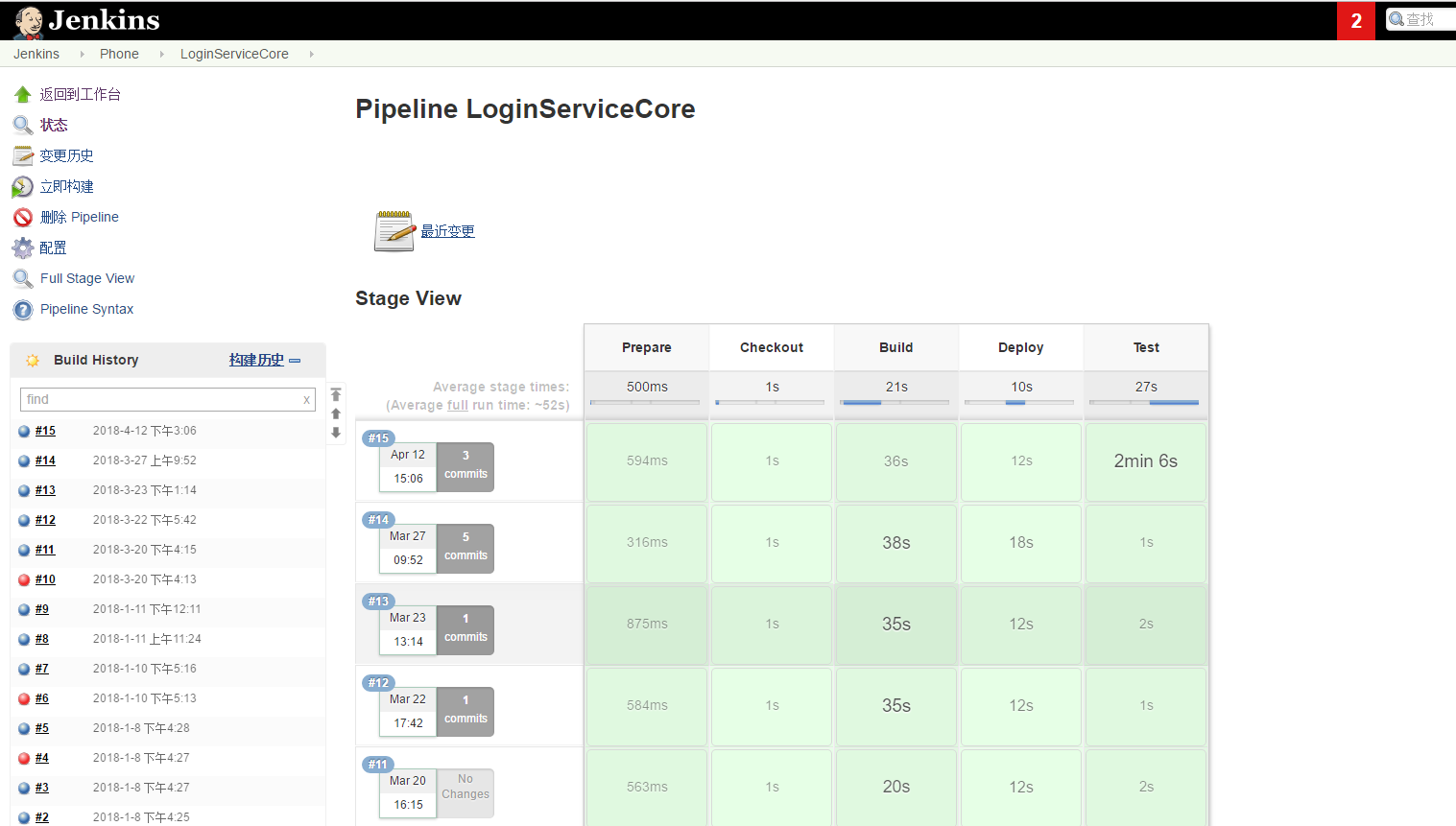前提引言
-
Jenkins的精髓是Pipeline(流水线技术),那为什么要用Pipeline呢?实现自动化构建,其中Pipeline能够将以前project中的配置信息以steps的方式放在一个脚本里,将原本独立运行于单个或者多个节点的任务连接起来,实现单个任务难以完成的复杂流程,形成流水式发布,构建步骤视图化。
-
简单来说,Pipeline适用的场景更广泛,能胜任更复杂的发布流程。举个例子,job构建工作在master节点,自动化测试脚本在slave节点,而不同节点的执行处理通过Pipeline可以。
基本概念
-
【Stage: 阶段】,一个Pipeline可以划分为若干个Stage,每个Stage代表一组操作。注意,Stage是一个逻辑分组的概念,可以跨多个Node。
-
【Node: 节点】,一个Node就是一个Jenkins节点,或者是Master,或者是slave,是执行Step的具体运行期环境。
-
【Step: 步骤】,Step是最基本的操作单元,小到创建一个目录,大到构建一个Docker镜像,由各类Jenkins Plugin提供。
Pipeline配置
新建一个“流水线”的job

配置Pipeline脚本

Pipeline也支持Poll SCM

pipline流水线流程

PIpeline语法
- Pipeline支持两种语法:Declarative Pipeline(在Pipeline 2.5中引入,结构化方式) 和 Scripted Pipeline,两者都支持建立连续输送的Pipeline。
共同点
两者都是pipeline代码的持久实现,都能够使用pipeline内置的插件或者插件提供的steps,两者都可以利用共享库扩展。
不同点:
-
两者不同之处在于语法和灵活性。Declarative pipeline对用户来说,语法更严格,有固定的组织结构,更容易生成代码段,使其成为用户更理想的选择。
-
但是Scripted pipeline更加灵活,因为Groovy本身只能对结构和语法进行限制,对于更复杂的pipeline来说,用户可以根据自己的业务进行灵活的实现和扩展。
下面举例介绍两种语法的使用
Declarative Pipeline
windows环境脚本案例
pipeline {
agent any //在可用的节点运行
stages{
stage ('Prepare'){
steps{
//清空发布目录
bat '''if exist D:\publish\LoginServiceCore (rd/s/q D:\publish\LoginServiceCore)
if exist C:\Users\Administrator\.nuget (rd/s/q C:\Users\Administrator\.nuget) exit'''
}
}
//拉取git代码仓库
stage ('Checkout'){
steps{
checkout([$class: 'GitSCM', branches: [[name: '*/master']], doGenerateSubmoduleConfigurations: false, extensions: [], submoduleCfg: [],
userRemoteConfigs: [[credentialsId: 'c6d98bbd-5cfb-4e26-aa56-f70b054b350d',
url: 'http://xxx/xxx/xxx']]])
}
}
//构建
stage ('Build'){
steps{
bat '''cd "D:\Program Files (x86)\Jenkins\workspace\LoginServiceCore\LoginApi.Hosting.Web"
dotnet restore
dotnet build
dotnet publish --configuration Release --output D:\publish\LoginServiceCore'''
}
}
//部署
stage ('Deploy'){
steps{
bat '''cd D:\PipelineScript\LoginServiceCore
python LoginServiceCore.py'''
}
}
//自动化测试(python代码实现)
stage ('Test'){
steps{
bat'''cd D:\PipelineScript\LoginServiceCore
python LoginServiceCoreApitest.py'''
}
}
}
}
Scripted Pipeline
node('master') { //master节点运行,以下stage也可指定节点
stage 'Prepare' //清空发布目录
bat '''if exist D:\publish\LoginServiceCore (rd/s/q D:\publish\LoginServiceCore)
if exist C:\Users\Administrator\.nuget (rd/s/q C:\Users\Administrator\.nuget)
exit'''
//拉取git代码仓库
stage 'Checkout'
checkout([$class: 'GitSCM', branches: [[name: '*/master']], doGenerateSubmoduleConfigurations: false, extensions: [], submoduleCfg: [], userRemoteConfigs: [[credentialsId: 'c6d98bbd-5cfb-4e26-aa56-f70b054b350d',
url: 'http://xxx/xxx/xxx']]])
//构建
stage 'Build'
bat '''cd "D:\Program Files (x86)\Jenkins\workspace\LoginServiceCore\LoginApi.Hosting.Web"
dotnet restore
dotnet build
dotnet publish --configuration Release --output D:\publish\LoginServiceCore'''
//部署
stage 'Deploy'
bat '''
cd D:\PipelineScript\LoginServiceCore
python LoginServiceCore.py
'''
//自动化测试(python代码实现)
stage 'Test'
bat'''
cd D:\PipelineScript\LoginServiceCore
python LoginServiceCoreApitest.py
'''
}
Pipeline Docker脚本示例
node{
// 代码检出
stage('get Code') {
git credentialsId: 'git-credentials-id', url: 'http://192.168.19.250/libo/test.git'
}
// 镜像中进行单元测试
stage('unit testing'){
// 启动golnag:1.7并在golang内编译代码
docker.image('golang:1.7').inside {
sh './script/unittest.sh'
}
}
// 镜像中代码构建
stage('Build'){
def confFilePath = 'conf/app.conf'
def config = readFile confFilePath
writeFile file: confFilePath, text: config
// 启动golnag:1.7并在golang内编译代码
docker.image('golang:1.7').inside {
sh './script/build.sh'
}
}
// 编译镜像并push到仓库
def imagesName = '192.168.18.250:5002/ufleet/uflow:v0.9.1.${BUILD_NUMBER}'
stage('Image Build And Push'){
docker.withRegistry('http://192.168.18.250:5002', 'registry-credentials-id') {
docker.build(imagesName).push()
}
}
// 启动刚运行的容器
stage('deploy iamegs'){
// 需要删除旧版本的容器,否则会导致端口占用而无法启动。
try{
sh 'docker rm -f cicdDemo'
}catch(e){
// err message
}
docker.image(imagesName).run('-p 9091:80 --name cicdDemo')
}
}
git操作认证
withCredentials([usernamePassword(credentialsId: '<credentials-id>', passwordVariable: 'GIT_PASSWORD', usernameVariable: 'GIT_USERNAME')]) {
sh '''
printf "machine github.com
login $GIT_USERNAME
password $GIT_PASSWORD" >> ~/.netrc
// continue script as necessary working with git repo...
'''
}
git拉取代码
checkout scm: ([
$class: 'GitSCM',
userRemoteConfigs: [[credentialsId: '******',url: ${project_url}]],
branches: [[name: 'refs/tags/${project_tag}']]
])